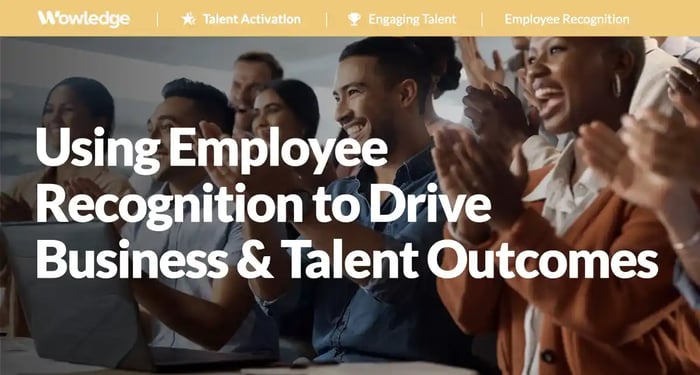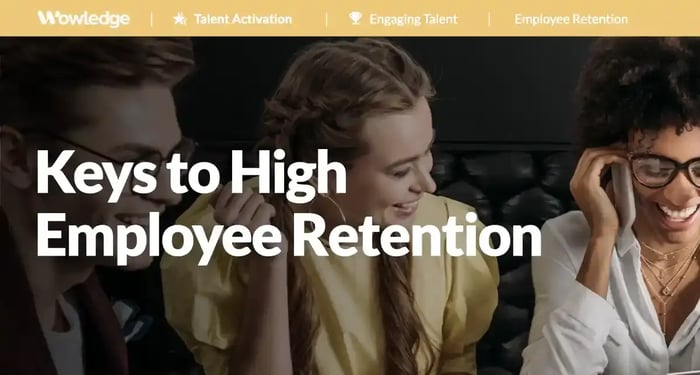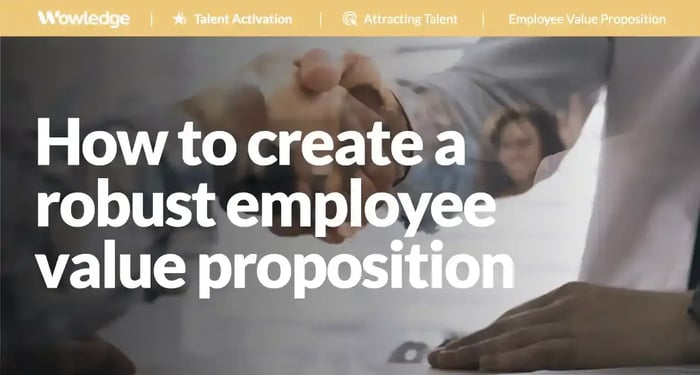Understanding how to motivate people best has been the subject of researchers, writers, and experts across disciplines for centuries. Its utility is evident in moving human behavior forward (and towards something) in environments and endeavors as varied as work, education, athletics, child-rearing, sales and marketing, healthcare and well-being, etc. A common thread as a driver of behavior across these is recognition, which is the provision of acknowledgment or positive feedback to an individual about their contributions or achievements. Leveraging employee recognition has been demonstrated as a consistent technique for boosting productivity, loyalty, and retention and is a cornerstone of strong people management.
Recognition plays a crucial role in meeting people’s fundamental need for acknowledgment, thereby communicating their value and reinforcing desired behaviors, actions, and efforts. It is a form of positive feedback that informs employees that they are meeting or exceeding expectations and aligning their conduct with the organization's standards. In fact, Gallup research has shown that when recognition is genuine and tied to their actions, employees are six times (6X) more likely to feel that their manager appreciates their performance.
How recognition is important
Recognition, in its various forms, is a versatile tool that acknowledges and communicates the value someone has added to a shared endeavor or objective. Employee recognition can be as simple as a 'thank you' for extending generosity, such as giving up a seat to an elderly person, or as elaborate as the presentation of a formal award in front of hundreds or thousands of people for a significant discovery or accomplishment, like winning a Nobel Prize. Whatever its nature, recognition is an essential element of the human condition.
The human brain is intricately wired and chemically tuned to respond to positive feedback. Medical evidence tells us that “recognition triggers the release of dopamine…a neurotransmitter produced in the brain that activates the reward-processing parts of the brain, generating positive emotions like satisfaction and enjoyment.” It also releases serotonin, a natural anti-depressant that produces feelings of well-being and lowers reactions to stress.
Recognizing employees also effectively and successfully drives behavior, as psychologists demonstrated in the 1970’s. For example, 92% of workers are more likely to repeat a specific action after receiving recognition, and 78% of employees work harder and with more drive when their efforts are rewarded.
The realities of employee recognition in the workplace
While some research suggests that 80% of companies have employee recognition programs, only one in three (1/3) workers report receiving any recognition or praise for doing good work in the past seven days. Another study shows that 29% of employees haven’t received recognition in over a year. Yet another found that 50% of surveyed workers would like more recognition. Another found that 39% of employees cited a lack of communication and recognition from management.
While 35% of employees say they receive recognition monthly or weekly, a lack of recognition is the 3rd highest reason for employee turnover. Less than 50% of employees report getting a sufficient amount of recognition for their work and accomplishments from their direct manager, and turnover is a regular part of the thinking of those underappreciated workers. Employees who receive less than they feel they deserve are twice (2X) as likely to say they plan to quit the following year. Similarly, 46% of workers quit their jobs due to a lack of recognition.
While recognizing employees' efforts, contributions, and accomplishments can come in many ways, the most common recognition they receive is service awards. These tenure-based awards reinforce employee retention (and, to many, survival) as opposed to the quality of work, the significance of their contributions to the corporate mission, revenue, profitability, innovation, etc. Forbes reported that 87% of all employee recognition programs are tied to length of service, yet only 58% of employees know about them. And almost 2/3 of businesses report that there is no budget for recognition programs. Given the high turnover rates and levels of cross-company talent movement, even those with employee recognition programs are not likely to motivate worker longevity.
The sad fact is that workers across the globe, industries, and career fields not only want more recognition but also tell us that they would put in greater effort if their managers provided them with such positive feedback. For example, 65% of workers in one study said they would work harder if their efforts were noticed by management, while another found that 80% of employees would work harder if they felt better appreciated. Whether through a formal program or managers' regular and consistent behaviors, recognizing employees appears to be a missed opportunity to generate significantly higher productivity.

The benefits of providing employee recognition
Recognizing employees' efforts and contributions makes sense to most people on the surface – we all recall how we felt when a teacher, coach, or parent told us we had done well. The sense of pride, validation, and self-worth that followed was often remembered for years afterward. The good news is that feeling is syndicated and compounded, as it reminds people what behaviors are appreciated and desired and lead to more considerable successes. The successes driven by more widespread recognition occur in business and talent outcomes – organizations where appreciation and rewards are given more frequently and effectively enjoy higher returns on these simple but elegant appreciation tactics.
Business benefits
The primary reason for considering establishing a strategy and supporting programs and tactics for recognizing employees is that organizations with solid recognition cultures produce better operating results. One SHRM study found that employee recognition programs helped increase profit margins by 58%. This is likely due to or related to the observation of increased employee productivity of 63%. Other studies have shown that companies in the top tiers of recognition practices and behaviors are twelve times (12X) more likely to generate superior business outcomes.
The results of recognizing employees multiply by building and enabling robust recognition environments. A Deloitte study found that compared to those without such programs, high-recognition organizations generate 14% higher engagement, productivity, and performance and that an engagement gain (alone) of that level, in turn, can drive a 2% increase in operating margin.
Those organizations with strong cultures of recognition also enjoy superior levels of innovation, where their employees are 33% more likely to be self-motivated to innovate by generating twice (2X) as many new ideas per month as their peers who do not receive regular and deserved recognition.
Talent outcomes
The impact of recognition on employee behaviors, work efforts, and productivity is significant, and from the work of behavioral scientists in the 1970s (shout-out to B.F. Skinner), the behavior-reward-behavior repeat cycle is a well-established fact of the human experience. When recognition is commonplace, and employees feel they have an equal shot at receiving it for their work, they are over twice (2.2X) as likely to exert discretionary effort above their typical job requirements. In fact, 80% of workers report working harder when receiving recognition from their bosses (while fewer than 40% will do so for an overly demanding one).
Not surprisingly, companies with formal employee recognition programs report 31% lower turnover than those without and are 2.7X more likely to enjoy high levels of employee engagement. Those employees tell us that such recognition is over three times (3X) more motivating than being given more job autonomy, 5X more than increased pay or training, and 9X more impactful than receiving a promotion.
The impact of recognition on employee retention is also substantial. Studies consistently demonstrate that point, such as the finding that recognized employees are six times (6X) more likely to stay than those without, and 53% of workers stated that they would stay longer if they felt more appreciated. Forbes reported that organizations prioritizing employee appreciation have workers who are 56% less likely to look for a new job. Showing gratitude and appreciation to employees for their efforts and contributions is a core element of addressing their basic human needs and a driver of their longer-term retention.
Employee well-being has emerged as a hot topic and priority driven by generational changes and post-pandemic workforce lessons. Employees who receive high levels of recognition find satisfaction in their contributions, higher self-worth, and lower stress levels, all due to the regular validation they get. They are 44% more likely to report that they are doing well in their personal lives, 73% less likely to feel frequent burnout and experience fewer emotional highs and lows, and stronger relationships with their co-workers.
Gallup found that employees who report a high level of recognition are 1.8X more likely to report that they are “thriving” in their personal lives while generating 2.3X higher job performance. Employee recognition has direct and significant benefits for the individual and organization alike.
Designing recognition from an employee’s perspective
Making recognition a standard and regular employee experience should be a goal in every organization. Regardless of budgetary limitations, recognition valued by workers and drives desired behaviors does not require substantial financial resources. Interesting insights can be generated using employee listening (engagement, pulse surveys, skip-level sensing sessions, etc.) vehicles or charter a team to use design thinking methodologies to engage employees and design affordable programming. Either way, we find that employees want recognition for contributions, and the source does not always have to be their direct manager.
Guiding design lessons gleaned from organizational research include:
- 71% of workers prefer recognition for significant accomplishments, 44% for their value to the company, and 43% for their teamwork or collaborations. They place the lowest value on recognition for non-work accomplishments, their potential, or their normal day-to-day work behaviors.
- 65% prefer non-cash incentives. These can come in the form of public awards, experiences, extra paid time off, etc.
- 41% want more peer recognition. Interestingly, 65% of employees in one survey said they would stay at a job with an unappreciative manager if their coworkers and peers still recognized their work. Peer feedback is 36% more impactful than congratulations from one’s manager.
- Employees with varied interests and needs increasingly value personalization. 35% of employees prefer that recognition is delivered through enhanced perks, bonuses, or recognition rewards programs. Programs that enable the accumulation of points that can be traded for sports equipment, electronics, travel, paid time off, worthy cause contributions, etc., support individualized preferences for more meaningful awards.
A key consideration comes from Deloitte research, which suggests that many recognition programs fail to motivate employees when they are overly focused on financial goals or rewarding service or tenure, which employees may not value. Consider the following best practices for creating a stronger and more impactful linkage between recognition efforts and desired employee outcomes.

Best practices in creating impactful employee recognition
Integrating recognition into organizational operations requires a thoughtful and comprehensive approach. Consider the full range of opportunities for leveraging recognition as a driver of employee behavior, work efforts, and tangible results. Think through how, when, where, and by whom they like to be acknowledged, and what business-related outcomes are meant to be supported. And understand that recognition takes many forms – formal and informal, financial and non-financial, interpersonal and public, momentary and lasting.
1. Define and promote meaningful recognition
Authenticity is the most critical aspect of any recognition. Gallup research suggests the best positive feedback is “meaningful, heartfelt, and honest.” People can see through empty flattery, self-serving praise, or comments made solely to say something nice. Recognize actions that the person can understand as above the norm, beyond normal expectations, or significant to the business, customers, or communities it serves.
Praise should be individualized (what the person did, contributed, or accomplished), specific (how it saved money, reduced processing time, helped complete a project on time), timely (soon after the contribution), and meaningful (how it was critical to a larger mission or objective).
2. Develop a strategy
Articulate a formal purpose, develop a business case, assign budgets, and create a governance structure to oversee the investments of time and efforts. Use this to communicate the intended value and outcomes gained from developing, supporting, and promoting the behaviors and activities. Define the criteria to guide managers' and employees' recognition of efforts, such as behaviors demonstrating corporate values, leadership competencies, and added value to the organization's mission or primary objectives. Integrate the strategy and its elements with those related to compensation, performance management, recruiting, management development, etc.
3. Support managerial skill development and execution
Considering the impact of managers on employee performance, retention, and engagement, training and monitoring their delivery of recognition is a core element of improvement. Building skills for regular authentic and meaningful employee recognition delivery during the increasingly common performance “check-ins” is essential. Guide their running of those weekly/bi-weekly/monthly meetings with standard questions about work or project progress and accomplishments that can serve as fodder for quality comments. Survey employees about the frequency and quality of recognition received as a tool to improve subsequent managerial delivery.
4. Make recognition a multi-party affair
Create opportunities and support for 360-degree recognition, with feedback mechanisms from not only direct supervisors but also co-workers, project managers, executives, customers, and suppliers. Actively communicate and encourage leaders and employees to recognize people throughout the chain of command and across organizational boundaries. Leverage employee recognition platforms that enable feedback and send “thanks” to others who have helped accomplish a goal or simplified their work. Consider that employees find hand-written notes and thank-you’s from the CEO or their EVP (per Gallup) the most memorable recognition occurrences in their careers.
5. Tailor programming and standards to local needs
Be prepared to tailor the strategy and program to meet local preferences and customs, particularly in multi-national locations. Consider issues with financial awards related to local laws, taxation, inflation, and other requirements. The power of individually tailored awards that leverage employee choice and preferences in what they value most can have an enormous impact on the success of such an effort. Offering a variety of rewards – time off, cash, experiences, contributions, etc. – can drive success with employees across regions, cultures, and generations.
6. Measure the outcomes
As with any organizational investment in time, resources, and budgets, measuring the effectiveness and impact of an employee recognition program is essential. On the financial front alone, Deloitte reports that while total recognition spending is approximately $46 billion annually, only 13% of those companies report tracking their return on investment (ROI). Measure managerial delivery (frequency and quality), employee perceptions (frequency, quality, who delivered), formal award (volume and spend levels), and impact upon retention, productivity, engagement, performance levels, profitability, and revenue. Report these with a cadence that enables managers to act on timely improvement opportunities and supports governance council requirements.
Relevant Practices & Tools
Developing Leaders Across Multiple Levels of Management. >
Advanced leadership development is designed to not only develop current executives, but "leaders" in all levels of the organization... more »
Building a Culture of Coaching and Mentoring that Creates a Continuous Learning and Improvement Environment. >
Establishing and managing a sustainable culture of coaching and mentoring is an integrated effort that builds an environment where continuous development and growth... more »
Using Technology to Deliver Streamlined HR Services and Insights. >
HR Technology has advanced to a level where it is currently capable of offering scalable productivity gains in processing HR transactions, with emerging technologies capable... more »
Providing Frequent Coaching and Feedback to Adapt and Adjust Performance Throughout the Year. >
Coaching & Mentoring is an employee development activity that, in the context of performance management, involves a manager providing feedback and guidance on an ongoing basis... more »
The Managers Guide to Performance Conversations Tool: Conduct and Record Regularly Occurring Manager-Employee Performance Conversations. >
A guide and template for leading regular manager-employee conversations regarding performance over a short (e.g., 1-4 weeks) period of time... more »
About Wowledge
Wowledge is the expert-driven platform for lean teams building strategic HR programs. Members enjoy access to up-to-date best practices, step-by-step guides, tools, templates, and insights to accelerate the design and implementation of all key HR programs and processes.
Since each organization has unique characteristics, needs, and aspirations, Wowledge's practices are developed utilizing an exclusive stage-based approach – from Core to Advanced to Emerging – that reflects distinct levels of sophistication to meet our members where they are.
Build strategic HR programs with refreshingly easy-to-follow best practices.
Get started for FREE! Learn more.










